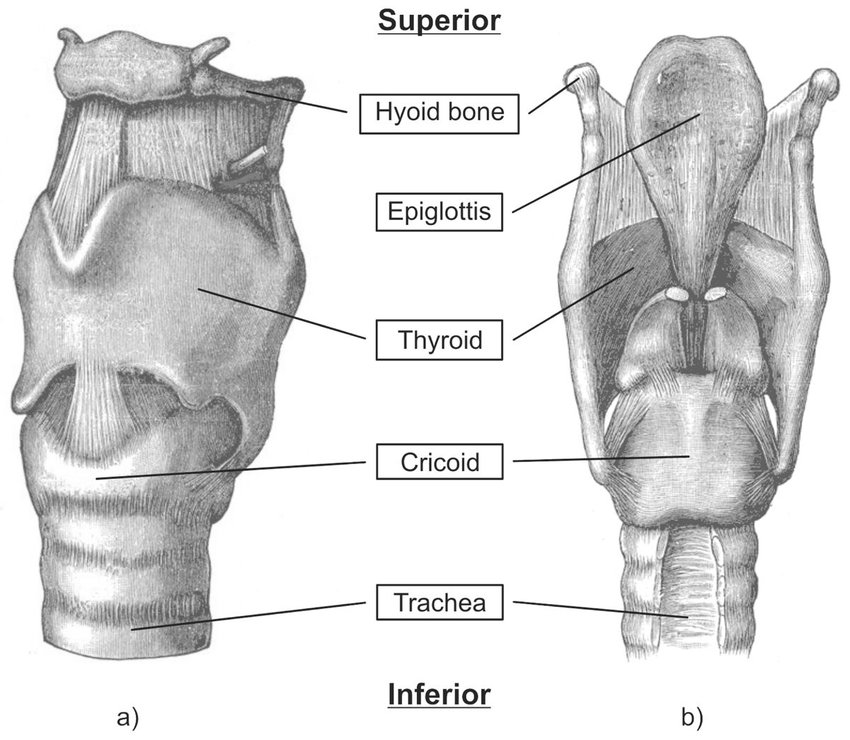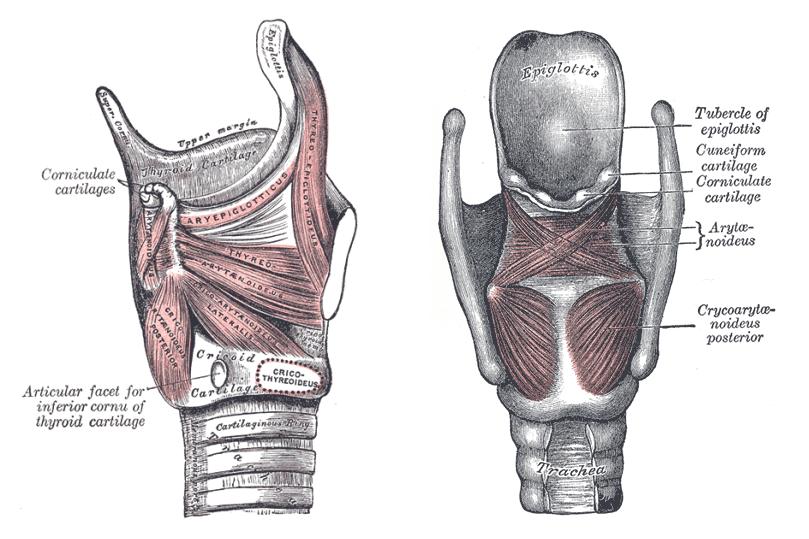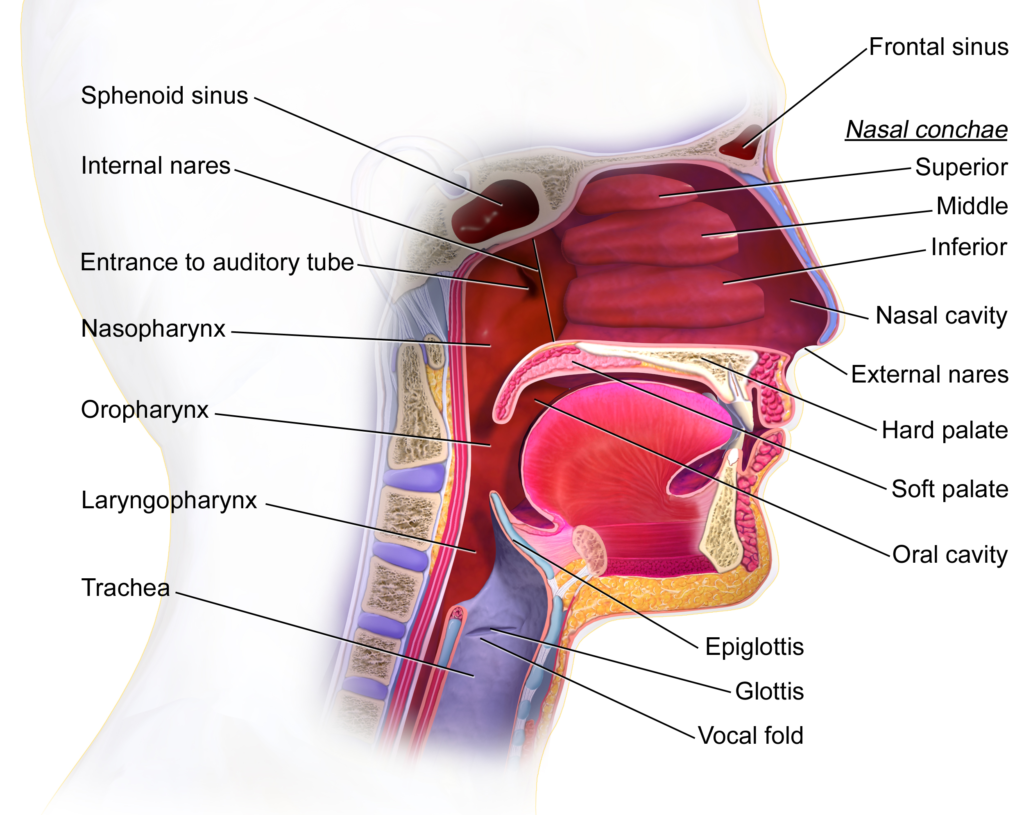At the top of the neck is a small tube-like organ that connects the throat (or pharynx) to the windpipe (the trachea). That organ is the larynx, colloquially called the “voice box”. The vocal cords are contained in the larynx, and it is involved in the general functions of manipulating pitch and volume to produce sound.

WHAT ARE THE FUNCTIONS OF THE LARYNX?
- The larynx is part of the entire structure that makes intake of air into the organs possible: the pharynx, larynx and trachea are interconnected.
- Phonation (vocal sounds) is generated from the larynx, this makes it the most important organ (in conjunction with the tongue) for speaking and producing sounds. The pitch of the sounds, their tone and volume are modulated by the larynx, in conjunction with the positioning of the tongue, the mouth and the lips. The entire framework of human consonant and vowel sounds depends on the alteration of sound and pressure in the larynx.
- The larynx also functions to prevent food and drink from entering the respiratory system to cause choking. When pieces of food enter the larynx, the response is a bout of coughing to bring them back up. The cough reflex is caused by a deep inhalation of air through the folds of the vocal cords, with attendant elevation of the larynx and then tightening of the vocal folds. The closing of the vocal folds will initiate a forced expiration (the cough) which expels the foreign object with the help of the expiration muscles. The lungs, tracheal muscles, tongue and mouth are all involved in the coughing reflex.

Another way that the foreign object can be removed is when the throat is cleared, with a similar but less forceful mechanism as coughing.
When we swallow, the larynx is also involved. The tongue rolls back and pushes the epiglottis over the opening of the glottis as the larynx pulls up, sealing off the entrance to the larynx to protect the lungs.
- The larynx is also involved in abdominal fixation. When we want to lift a heavy weight, there is an instinctual reaction where air is taken into the lungs (we don’t think of this, but this is so that the thorax can stiffen and provide support for the lift). The vocal folds of the larynx close to aid in holding in that air. The occasional grunts that escape while carrying or lifting heavy objects is due to occasional escape of the trapped air.
GREAT BOOKS WE RECOMMEND, CLICK ON THE IMAGE TO KNOW MORE! 🙂
ANATOMICAL STRUCTURE OF THE LARYNX
The larynx can be anatomically divided into three parts: the supraglottis which lies from the epiglottis to the vestibular folds, the glottis which contains the vocal folds (vocal cords), and the subglottis which goes from the inferior part of the glottis to the inferior part of the cricoid cartilage.
POSITION
The larynx can be found at the C3-C6 spinal vertebrae in front of the oesophagus. Its skeleton is made up of three single cartilages and three paired cartilages. The whole structure is suspended from the hyoid bone, which holds the larynx.
The larynx is covered on its anterior side by the infrahyoid muscles and on its sides by the thyroid gland.

SKELETON
The skeleton of the larynx is cartilaginous and divided into two types:
Single laryngeal cartilages
The thyroid cartilage is the largest laryngeal cartilage. It is responsible for holding one end of the vocal ligament and has an anterior protrusion that presents more prominently in men: commonly known as the Adam’s apple. It is supported by the hyoid bone; to which it is attached by a ligament.
The cricoid cartilage is shaped like a signet ring and attaches itself below the thyroid cartilage by a ligament.
The epiglottic cartilage has a network of mucous membrane covering it, forming the epiglottis. It functions as a stopper that prevents food from entering in through the larynx to the lungs.
Paired laryngeal cartilages
The arytenoid cartilages are shaped like pyramids, and form the other end of the support structures of the vocal ligament with the thyroid cartilage. They are movable and involved in the subtle changes in position that can relax or contract the vocal folds.
The cornilate cartilages are attached to the tip of the arytenoid cartilages on top of them.
The cuneiform cartilages lie below the arytenoid cartilages, unattached to any others.


GREAT BOOKS WE RECOMMEND, CLICK ON THE IMAGE TO KNOW MORE! 🙂
MUSCULATURE
The muscles attached to the larynx are the major players in the movement of the entire voice box and its attendant parts. They hold up the cartilage and ensure mobility, while supporting the larynx in its respiratory functions. The laryngeal muscles can be divided into two broad groups:
Extrinsic laryngeal muscles move the whole larynx up or down.
Upwards moving muscles are:
- Digastric
- Stylohyoid
- Mylohyoid
- Geniohyoid
- Hyoglossus
- Genioglossus
- Thyropharyngeus
Downward moving muscles are:
- Sternohyoid
- Omohyoid
- Sternothyroid
- Thyrohyoid

Intrinsic laryngeal muscles are involved in the changes in position that are needed for phonation and sound production. They control the movements of the vocal cords and cartilages. They are:
- Posterior cricoarytenoid
- Lateral cricoarytenoid
- Interarytenoids
- Thyroarythenoids
- Cricothyroid
- Aryepiglottis
- Thyroepiglottis

GREAT BOOKS WE RECOMMEND, CLICK ON THE IMAGE TO KNOW MORE! 🙂
GLOTTIS
The glottis is the main part of the larynx. It is the part that is concerned with sound production and modulation and is made up of the vocal folds (vocal cords) and rima glottides.
- The vocal chords are made up of two vocal ligaments with a space between them, attached at various places to the vocalis muscle.
The rima glottidis is the space between the vocal cords, and the changes in its size and shape are what produce different sounds at different pitches.

INNERVATION
The larynx’s major nerve supple is from the recurrent laryngeal nerve, which is part of the vagusnerve (cranial nerve x). The recurrent laryngeal nerve supplies all the intrinsic and extrinsic muscles of the larynx. The only muscles exempted from this are the crichothyroidmuscles, which is supplied by part of the superior laryngeal nerve (a branch of the vagus nerve) instead.
CAVITIES
There are three cavities that can be found in and around the larynx and play a role in sound production:
- The laryngeal vestibule is a cavity directly above the vestibular folds-which protect the vocal cords and are sometimes called the false vocal chords.
- The middle of the laryngeal cavity is between the vestibular folds and the vocal cords.
The lower laryngeal cavity is the infraglottic space, which is between the vocal cords and the lower part of the opening of the larynx into the trachea.

DISORDERS OF THE LARYNX
Just like any other organ in the body, the larynx is subject to damage and disease, both acquired and congenital.
These are some of the most common disorders of the larynx:
- Laryngitis is inflammation of the larynx caused by different factors like dust, smoking, shouting or cold. Acute laryngitis is of sudden onset, usually characterized by “loss of voice” and pain while talking. It is not a serious medical condition and will usually go away with soothing treatments like mints and resting the voice to enable the swelling go down.
Chronic laryngitis is a more serious condition, caused by prolonged exposure to environmental irritants like dust and polluted air. Smoking can also cause and exacerbate chronic laryngitis (characterized by the hoarse “smokers’ voice”).
- Exposure to endotracheal tubes in patients who have been intubated for a long time can cause ulcers to form on the larynx.
- Cancer of the larynx is of two types: squamous cell carcinoma and verrucous carcinoma, both of which are caused and exacerbated by cigarette smoking and a prolonged habit of alcoholism.
- Vocal fold paresis occurs when one or both of the recurrent laryngeal nerves that enervate the vocal folds are impaired by injury, whether mechanical or systemic. The condition could affect one or both of the folds. The disorder causes shortness of breath and other breathing problems, snoring, and inability to maintain physical activity for a long time due to loss of breath.
- Laryngospasms have no known cause, but they are common with a frequency that varies in different individuals. Here, the vocal folds close due to the spasming of the laryngeal muscles, causing difficulty in breathing in that can last up to a minute before it resolves. It can happen whether the person is awake or asleep, and has been linked to about 10% of drowning incidents.
- People can develop polyps on their vocal folds due to cigarette smoking. Polyps are small bumps on the vocal folds that alter sounds that come from it. The same presentation can happen when nodules form on the vocal folds due to vocal misuse, for example in singers who frequently sing in high notes that stress their larynx. A simple but delicate surgery can remove the polyps and nodules.
- Laryngomalacia is common in children due to the softness of their still growing laryngeal cartilages. The soft cartilage falls inwards when they breathe in, causing an obstruction that presents as noisy breathing and snoring.
- Laryngopharyngeal reflux is a condition usually seen in bulimic patients of people who throw up often. It can also present in people who have frequent acid reflux. This is irritation and burning of the larynx by stomach acid.
GREAT BOOKS WE RECOMMEND, CLICK ON THE IMAGE TO KNOW MORE! 🙂



